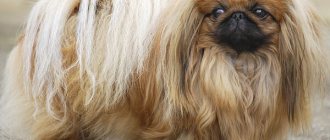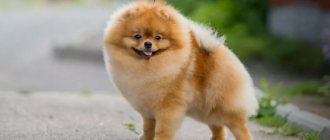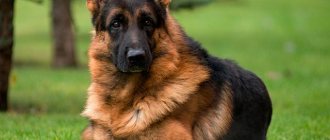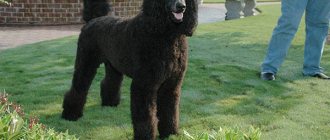Dobermans are associated with strength and endurance. Looking at them, it seems that they do not know illness. But that's not true. Unfortunately, the breed is prone to many diseases, so breeders worry that their pets may die too early. Owners are wondering how long their pets will live, and what could cause their early death.
Average life expectancy for boys and girls
With proper care and the absence of congenital pathologies, Dobermanns live 12-15 years. Moreover, the average life expectancy of females is one year longer than that of males. Girls are less susceptible to breed-specific diseases, including cancer.
The length and quality of life of representatives of this breed are influenced by:
- Feeding. Dobermans' food must be of high quality, balanced and contain all the vitamins and minerals necessary for the dog's growth, development and health.
- Care. Dobermans are quite hardy and do not require specific care like, for example, representatives of dwarf breeds. At the same time, being active dogs, they need regular walks and physical activity, and due to their short coat, it is necessary to ensure that the pet does not suffer from hypothermia in winter.
- Genetics. This breed was bred artificially, which makes its representatives prone to a number of hereditary genetic diseases. Thus, the presence of severe pathology in a bitch indicates that in 80% of cases it will be passed on to puppies.
According to statistics, the maximum age of Dobermans is 16 years, the minimum is 5.
Description of the breed
Doberman Pinschers were bred in Germany to be guard dogs. They have a high level of intelligence, courage and strength, which are essential qualities for guard dogs. But unlike other fighting breeds, Dobermans are much less likely to attack people , and they treat the family in which they live with love.
Over time, this breed has changed a little - the dogs have become more good-natured than the first puppies bred, but they still retained their fighting qualities.
These dogs are distinguished by their high reaction speed, tenacity and arrogance. In view of the last characteristic, the owner will have to make a lot of effort so that the animal recognizes him as the main one.
Differences in the period of residence at home and on the street
Dobermans can be kept both indoors and outdoors. In the first case, the dog develops a more stable psyche, since the animal does not experience stress due to loneliness or lack of attention. In addition, your pet's risk of colds is reduced.
Street maintenance is also possible. To prevent it from causing a shortening of the Doberman's life, it is important to follow some rules. Firstly, you need to purchase or build yourself a fairly spacious enclosure and a booth, the size of which should not hinder the movements of the Doberman. The dog's home should be insulated; in winter, it is ideal to provide heated floors and walls.
You need to make sure that your pet always has all the necessary things freely available: toys, treats, water and food. Also, despite the dog’s constant presence outside in an enclosure, it is required to walk it daily and play with it, giving it the opportunity to get rid of accumulated energy. Otherwise, the risk of your pet losing activity, developing mental disorders, obesity and other diseases increases.
Factors influencing the lifespan of Doberman Pinschers
The Doberman is an easy-going, easy-to-train dog. It can be kept both in a comfortable home environment and in an aviary. On the street, the space is fenced off in the shade. This breed does not tolerate heat. The Doberman's coat is short, so technically it is necessary to think through the heating system. In extreme cold, keep your pet indoors.
In order for a devoted friend to live as long as possible, you need:
- Daily walks in all weather conditions, training and games;
- Minimum required care (combing, water treatments, trimming nails);
- Feeding should not be monotonous. It is better to combine natural food with dry food;
- A loving owner will not forget to follow the vaccination schedule and monitor his health.
The main condition of keeping is love for the animal. When a healthy, majestic Doberman walks on a leash next to its owner, this is not a source of pride. Regular training and socialization will help the dog become a well-mannered companion, ready to protect his family. Healthy Dobermans, even in old age, can participate in exhibitions.
Main causes of premature death in females and males
According to statistics, the main cause of premature death in Doberman Pinschers, both females and males, is illness. Even with proper care and proper living conditions, there is no guarantee that the pet will not suddenly develop a disease or manifest a hereditary pathology.
Representatives of this breed often suffer from cardiovascular diseases. Among the most common pathologies leading to death is cardiomyopathy. This disease is difficult to cure due to the fact that diagnosis at an early stage is impossible. Therefore, about 25% of sick animals do not survive to the last stage.
At an early age, Dobermans may experience problems in the gastrointestinal tract, which in half of the cases end in the death of the animal. Another reason for the early mortality of representatives of this breed is cancer. If oncology is detected at a late stage of development, the disease cannot be treated and leads to the death of the animal.
In addition, Dobermans have genetic instability of the psyche, which can also cause early death, since it often leads to a condition incompatible with life. However, in this case, the problem can be corrected with the help of proper education, socialization and training.
Number of years according to statistics
If you analyze the statistical data, a depressing trend immediately becomes visible . Thirty years ago, the life expectancy of Dobermans was 9 years, and already in 2011 the indicators dropped to 5 years.
The most common causes of death for Dobermans are cancer and DCM (dilated cardiomyopathy) . According to the first indicator, dogs aged 7-9 years are at risk; younger dogs die from cancer much less frequently. Doberman Pinschers aged 5-7 years are most often affected by DCM.
What is noteworthy is that females live longer than males and suffer less from diseases. Their lifespan is on average a year longer - this figure fluctuates from year to year, but still, girls have always lived longer, since the very foundation of this breed.
Until 1985, half of Dobermans crossed the threshold of 10 years - this is a good indicator. But after 2000, the percentage of elderly dogs dropped to 25%.
Of course, times change, and the influence of the environment and other factors affects the lives of not only Dobermans, but also other dog breeds.
Also, do not forget that this is an artificially bred breed, and therefore these dogs are more susceptible to negative reactions to external factors than ordinary mongrels.
We also recommend reading other articles about the characteristics of this breed - height, weight, and what to feed the Doberman.
Top 15 diseases to which they are most susceptible
Despite the strength and endurance of representatives of this breed, there are a number of diseases that they are most often diagnosed with:
- Wobbler's disease. A disease that affects the bones of the neck and causes a change in the Doberman's gait, causing it to become shaky and unsteady.
- Vitiligo. A pathology that causes the skin to lose pigment.
- Fibrosarcoma and melanoma. Types of malignant neoplasms.
- Stomach torsion. A serious and dangerous disease that develops as a result of the stomach filling with air.
- Alopecia. Hair loss.
- disease . A pathology in which the blood does not clot. This can be fatal due to blood loss even with a minor injury.
- Atrial septal defect. Congenital heart disease.
- Parvovirus. An infectious disease that affects the gastrointestinal tract and occurs most often in unvaccinated puppies.
- Intervertebral disc disease. In the case of this pathology, the animal experiences back pain and finds it difficult to walk. As a result, paralysis may occur.
- Diabetes. A disease in which the body does not produce enough insulin. As a rule, diabetes occurs due to genetic predisposition, hormonal imbalance, obesity or pancreatitis.
- Dilated cardiomyopathy. Heart disease, due to which a film envelops it.
- Turn of the century. An ophthalmic disease in which the eyelid turns inward.
- Hypothyroidism. Pathology of the thyroid gland, causing the production of insufficient amounts of hormones.
- Chronic hepatitis. Inflammation of the liver, which results in scarring.
- Hip dysplasia. Joint damage leading to arthritis and lameness.
Some of these diseases are treatable, others are not. If the disease cannot be cured, the dog's owner can only provide the dog with proper care to alleviate its condition and maintain its well-being with medications prescribed by the veterinarian.
Good heredity
Do not hesitate to ask the breeder about the health of his dogs, possible problems, and the age of your puppy’s ancestors. If the questions are answered directly and in detail, and the information does not differ from the average for the breed, this is a good sign. Find out, in order to avoid hereditary pathologies, which crossing method was used in the nursery to produce offspring: inbreeding (inbreeding) or outbreeding, sometimes called crossbreeding (crossing of unrelated individuals). Remember: propagation is not the same as breeding. In the first case, only individuals of the opposite sex are required, in the second, work is meant to improve the breed qualities of the dog. A responsible breeder will be sure to provide you with all the information you need.
Extension of deadline
Every loving owner thinks about how to prolong the life of a pet. Knowing the main causes of premature death of Dobermans, it is important to carefully monitor the physical and psychological condition of the pet in order to notice any changes in time and contact a specialist. Also, one should not neglect regular scheduled examinations by a veterinarian, violate the basics of proper nutrition and care, and ignore the need of representatives of this breed for walks and active games.
Proper nutrition
The Doberman's diet can consist of both natural products and industrial feed. The main thing is to follow the basic rules:
- Nutrition should be balanced, varied and contain all the necessary vitamins, macro- and microelements.
- It is necessary to follow the feeding regime.
- Food should always be fresh and at room temperature.
- Dobermans should not be fed soups; their food should be thick.
- The volume of portions should be increased in case of increased physical activity or changes in the physiological state of the pet (pregnancy and lactation in females).
You cannot mix both types of feeding and change the puppy’s diet for at least a month after purchasing it.
A natural feeding pet's daily diet should include fruits, vegetables, low-fat dairy products, cereals, lean meat and fish. You cannot feed your dog smoked meats, pickles, marinades, fatty meats, sausages, bakery and pasta products, potatoes, and legumes. When choosing industrial feed, preference should be given to premium or super-premium products. The most popular brands of cows are Royal Canin, Hills, Eukanuba, Pro Plan, Acana, Orijen.
Quality maintenance and care
Caring for Dobermans is simple and involves regular hygiene procedures:
- Wipe the coat once a day with a towel and weekly with a stiff brush.
- Bath twice a year, otherwise there is a risk of decreased immunity.
- Wipe your eyes daily with a cotton pad soaked in boiled water or chamomile infusion.
- Clean your ears regularly using special drops and cotton swabs.
- Keep sleeping area, toys and bowls clean.
- Promptly carry out deworming, vaccination and treatment against external parasites.
It is important that the pet has enough space to live, communicate with the owner, walk and exercise.
How to extend the life of a pet?
The life of a family pet is already short compared to a human, so the desire of loving owners is not to be separated from their pets for as long as possible.
Having studied the main causes of mortality among Dobermans, it is important to adhere to the following rules to prolong his life:
- be attentive to any changes in the physical and emotional state of the pet;
- perform regular scheduled examinations with a veterinarian;
- adhere to the basics of proper nutrition and care;
- Take frequent walks with active games, pay attention and show love to your pet.
Effect of castration and sterilization
There are several reasons for castration or sterilization:
- Taming the temperament of a hyperactive animal.
- Eliminating the risk of unplanned offspring.
- Medical indicators - a disease or the likelihood of its development that requires radical action.
The procedure does not directly affect the pet’s quality of life. However, after surgery, the dog lives differently and needs special care and nutrition. The pet's risk of obesity, sleep disturbances, digestive problems and other complications increases. After spaying or neutering, the Doberman's health and longevity depend on exercise and diet.
Sterilization indirectly affects a dog's life expectancy, since it reduces the risk of developing testicular and prostate cancer in males and ovarian and mammary gland cancer in females.
Proper nutrition
Dobermann can be fed dry food or a natural diet.
Pay attention to what the puppy ate before you purchased it and follow the breeder's feeding schedule, because... A sudden change in diet can harm the baby.
Under no circumstances should you mix dry and natural food, as this can cause irreparable damage to your pet’s digestive system.
When choosing a natural diet, adhere to the following feeding rules:
- Offer your pet a balanced, varied and vitamin-rich diet;
- develop a certain eating regimen and follow it;
- Doberman's food should be thick, soups are not suitable for him;
- With increasing physical activity and pregnant (nursing) bitches, it is necessary to increase the volume of meat portions.
Products necessary for the full development and longevity of the Doberman:
- meat (beef, lamb, veal, chicken) and fish - 600-800 g per day;
- porridge (buckwheat, rice, oatmeal) - 500-700 g per day;
- cottage cheese up to 300 g;
- fermented milk products up to 200 g;
- fresh vegetables and fruits - 200 g.
Any smoked meats, fatty meats, sausages, pasta, potatoes, bread, legumes and generally food from the “master’s table” should be excluded from the dog’s diet.
Caring for an older dog
Caring for an elderly pet does not require major changes, you just need to make some minor adjustments:
- In the diet, focus on white meat (rabbit, fish, poultry), since many dogs develop kidney problems with age.
- Maintain fluid balance in your pet's body and ensure that the water bowl is always full.
- Reduce the number of active games, do not overload the dog.
In addition, it is necessary, as before, to monitor the hygiene of the animal and its home.
Signs of aging
The first sign of aging is the animal's changing color. The appearance of gray or silvery hairs indicates the beginning of the decline of the body.
The breed description contains information about the condition of the young animal's coat. It should be shiny and smooth. An old dog loses its shine, moves little, eats less, and develops dental problems.
The main sign of the onset of old age is not age, but the dull eyes of a pet without the former playful sparkle. Representatives of the breed live long if provided with sufficient physical activity. In old age, they can no longer walk for long periods of time; some individuals develop shortness of breath from climbing stairs.
Age, compared to human years
To better understand the social intelligence and emotional sphere of dogs, their age is compared with humans:
| Doberman's age (in years) | Person's age (in years) |
| 2 months | 14 months |
| 6 months | 5 |
| 8 months | 9 |
| 1 | 14 |
| 1,5 | 20 |
| 2 | 24 |
| 3 | 30 |
| 4 | 36 |
| 5 | 40 |
| 6 | 42 |
| 7 | 49 |
| 8 | 56 |
| 9 | 63 |
| 10 | 65 |
| 11 | 71 |
| 12 | 75 |
| 13 | 80 |
| 14 | 84 |
| 15 | 87 |
brief information
| Breed name | Doberman |
| Country of origin | Germany |
| Time of appearance of the breed | XIX century |
| Breed type | Service dog |
| Adult dog weight | 32-35 kg (females), 40-45 kg (males) |
| Height (height at withers) | 63-68 cm (females), 68-72 cm (males) |
| How long do they live? | 10-13 years |
| Popular nicknames | Atlant, Baron, Don, Zeus, Bulat |
A large service dog breed with an athletic build.
Peculiarities
Decorative dwarf chickens have been bred for many years. Poultry of this species is characterized by high productivity and is perfect for both breeding laying hens and preparing reserves of the most tender meat. If you provide your dwarf chicken with proper care and feed it properly, then in the future she can demonstrate excellent egg production.
The main advantage of charming dwarf chickens is that they consume much less feed than their counterparts. These poultry do not need to build a separate non-standard chicken coop. Dwarf chickens do not need large areas - they can live quietly in small buildings.
Also, dwarf chickens are characterized by an easy-going and calm character. They are very peaceful and do not cause serious inconvenience to their owners. Small chickens can coexist without problems with other animals in the same area. They produce no less eggs than birds of normal standard size.
The only problem that a poultry farmer may encounter is a highly developed nesting instinct. For this reason, it is recommended to prepare a good incubator for small chickens.
These pet birds require baths with water, sand and clay. With such components, dwarf chickens can easily get rid of various kinds of parasites that often appear on the body of birds or in their plumage.











